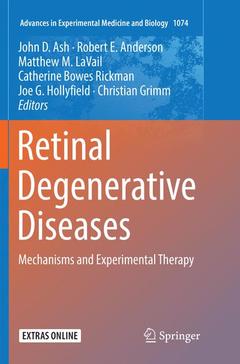Description
Retinal Degenerative Diseases, Softcover reprint of the original 1st ed. 2018
Mechanisms and Experimental Therapy
Advances in Experimental Medicine and Biology Series, Vol. 1074
Coordinators: Ash John D., Anderson Robert E., LaVail Matthew M., Bowes Rickman Catherine, Hollyfield Joe G., Grimm Christian
Language: English
Subjects for Retinal Degenerative Diseases:
Publication date: 02-2019
Support: Print on demand
Publication date: 05-2018
Support: Print on demand
Description
/li>Contents
/li>Biography
/li>Comment
/li>
The blinding diseases of inherited retinal degenerations have no treatments, and age-related macular degeneration has no cures, despite the fact that it is an epidemic among the elderly, with 1 in 3-4 affected by the age of 70. The RD Symposium will focus on the exciting new developments aimed at understanding these diseases and providing therapies for them. Since most major scientists in the field of retinal degenerations attend the biennial RD Symposia, they are known by most as the ?best? and ?most important? meetings in the field.
The volume will present representative state-of-the-art research in almost all areas of retinal degenerations, ranging from cytopathologic, physiologic, diagnostic and clinical aspects; animal models; mechanisms of cell death; candidate genes, cloning, mapping and other aspects of molecular genetics; and developing potential therapeutic measures such as gene therapy and neuroprotective agents for potential pharmaceutical therapy.
While advances in these areas of retinal degenerations will be described, there will be many new topics that either were in their infancy or did not exist at the time of the last RD Symposium, RD2014. These include the role of inflammation and immunity, as well as other basic mechanisms, in age-related macular degeneration, several new aspects of gene therapy, and revolutionary new imaging and functional testing that will have a huge impact on the diagnosis and following the course of retinal degenerations, as well as to provide new quantitative endpoints for clinical trials.
Many of the successes recently reported in these areas of retinal degeneration sprang from collaborations established at previous RD Symposia, and many of those will be reported at the RD2018 meeting and included in the proposed volume. We anticipate the excitement of those working in the field and those afflicted with retinal degenerations will be reflected in the volume.
John D. Ash, Ph.D., Francis M. Bullard Eminent Scholar Chair in Ophthalmological Sciences, Department of Ophthalmology, College of Medicine at the University of Florida. Dr. Ash received his Ph.D. from the Ohio State University Biochemistry Program in 1994, and completed postdoctoral training in the Cell Biology Department at Baylor College of Medicine, in Houston, Texas, and began his faculty career at the University of Oklahoma Health Sciences Center, Oklahoma. Dr. Ash is also a Visiting Professor at the Dalian Medical University, Dalian China. Dr. Ash has written and published 60 manuscripts including research articles, book chapters and invited reviews, and has edited four books. He is currently an Executive editor for Experimental Eye research and a Scientific Review Editor for Molecular Vision. Dr. Ash is an active reviewer for these journals as well as Investigative Ophthalmology & Visual Science. In 2009, Dr. Ash received a research award from Hope for Vision, and in 2010 he received a Lew R. Wasserman Merit award from Research to Prevent Blindness, Inc. Dr. Ash has received grants from the National Institutes of Health, the Foundation Fighting Blindness, Research to Prevent Blindness, Inc., Hope for Vision, and the American Diabetes Association. Dr. Ash has served on the Program and Advocacy committees of the Association for Research in Vision and Ophthalmology. Dr. Ash has served on the scientific review panel for Fight For Sight (2005-2008) and is currently serving on the Scientific Advisory Board of the Foundation Fighting Blindness (Columbia, MD) where he chairs the review committee on Novel Medical Therapies Program. He also serves on the scientific review panel for the Macular Degeneration program of the BrightFocus Foundation (formerly the American Health Assistance Foundation, Clarksburg, MD).
Robert Eugene Anderson, MD, Ph.D., is George Lynn Cross Research Professor, Dean A. McGee Professo




